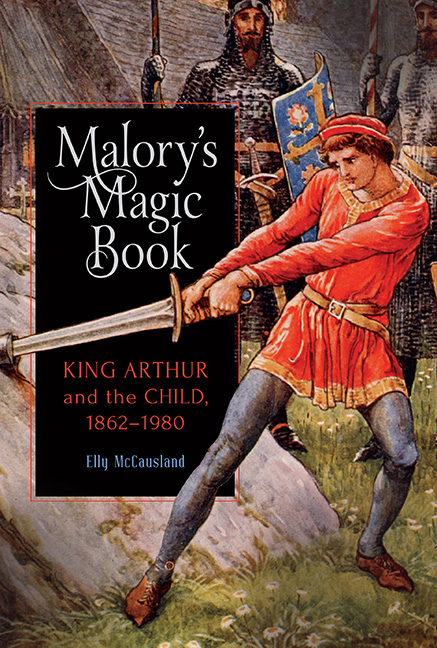Book contents
- Frontmatter
- Dedication
- Contents
- List of illustrations
- Acknowledgements
- A note on names
- Introduction
- 1 ‘Ever fresh and fascinating to the boy and girl of today’: the timeless child and the childish medieval in nineteenth-century Arthuriana
- 2 Risk and revenue: adventurous Arthurian masculinities in the work of Howard Pyle and Henry Gilbert
- 3 The ill-made adult and the mother's curse: psychoanalysing the Arthurian child in T. H. White's The Once and Future King
- 4 ‘Monty Python was not that far away’: the instability of 1950s Arthuriana for children
- 5 ‘For a little while a magician’: potent childish fantasies in John Steinbeck's Acts of King Arthur and his Noble Knights
- Conclusion: At the crossing-places
- Bibliography
- Index
- Arthurian Studies
3 - The ill-made adult and the mother's curse: psychoanalysing the Arthurian child in T. H. White's The Once and Future King
Published online by Cambridge University Press: 04 April 2019
- Frontmatter
- Dedication
- Contents
- List of illustrations
- Acknowledgements
- A note on names
- Introduction
- 1 ‘Ever fresh and fascinating to the boy and girl of today’: the timeless child and the childish medieval in nineteenth-century Arthuriana
- 2 Risk and revenue: adventurous Arthurian masculinities in the work of Howard Pyle and Henry Gilbert
- 3 The ill-made adult and the mother's curse: psychoanalysing the Arthurian child in T. H. White's The Once and Future King
- 4 ‘Monty Python was not that far away’: the instability of 1950s Arthuriana for children
- 5 ‘For a little while a magician’: potent childish fantasies in John Steinbeck's Acts of King Arthur and his Noble Knights
- Conclusion: At the crossing-places
- Bibliography
- Index
- Arthurian Studies
Summary
At the beginning of T. H. White's The Ill-Made Knight, published in 1941, the young Lancelot examines his reflection in the polished surface of a helmet:
He turned the hat in various directions, hoping to get an average idea of his face from the different distortions which the bulges made. He was trying to find out what he was, and he was afraid of what he would find.
The boy thought that there was something wrong with him. All through his life – even when he was a great man with the world at his feet – he was to feel this gap: something at the bottom of his heart of which he was aware, and ashamed, but which he did not understand. There is no need for us to try to understand it. We do not have to dabble in a place which he preferred to keep secret.
Poised here between the state of being a boy and a ‘great man with the world at his feet’, Lancelot suffers a crisis of identity and selfhood. The helmet, symbol of the chivalric glory that awaits the young man in his career at Arthur's Round Table, serves simultaneously to predict and symbolise his identity and to call it into question, offering a distorted and continually shifting reflection. Its bulges mirror Lancelot's perceived flaws, throwing his self-doubt and shame into sharp relief. ‘There is no need for us to try to understand it’, the narrator declares, yet the rest of the book is concerned with probing, dabbling in, this ‘secret place’ that is for Lancelot the locus of his distortion, doubt and self-loathing. Through the title the ‘ill-made knight’, an epithet that both foregrounds the formative influence of youth and warns of its potentially detrimental effects in later life, White locates the site of this conflict in Lancelot's childhood. His adaptation of the Morte Darthur continues the trend set by Howard Pyle and Henry Gilbert, introducing Malory's knights in their youth and tracing their development from children to adults. The first book of White's tetralogy, The Sword in the Stone, is almost entirely original, focusing on the adventurous childhood of ‘the Wart’ (Arthur) and his joyful education in self-reliance under the watchful eye of Merlin and his magical powers.
- Type
- Chapter
- Information
- Malory's Magic BookKing Arthur and the Child, 1862–1980, pp. 83 - 114Publisher: Boydell & BrewerPrint publication year: 2019



